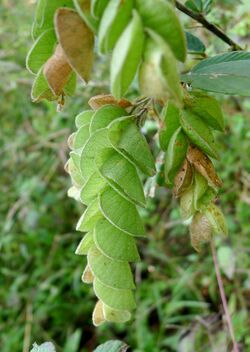Biology:Flemingia strobilifera
| Flemingia strobilifera | |
|---|---|

| |
| Green bracts of inflorescence | |
| Scientific classification | |
| Kingdom: | Plantae |
| Clade: | Tracheophytes |
| Clade: | Angiosperms |
| Clade: | Eudicots |
| Clade: | Rosids |
| Order: | Fabales |
| Family: | Fabaceae |
| Subfamily: | Faboideae |
| Genus: | Flemingia |
| Species: | F. strobilifera
|
| Binomial name | |
| Flemingia strobilifera | |
| Synonyms[2] | |
| |
Flemingia strobilifera, commonly known as the luck plant or wild hops, is a perennial flowering plant in the legume family, Fabaceae, and subfamily Faboideae. It is native to South, East and Southeast Asia.
Range
It is common in China , Taiwan, Bhutan, India , Nepal, Pakistan , Sri Lanka, Laos, Myanmar; Thailand, Vietnam, Indonesia, Malaysia, Papua New Guinea and Philippines .[1]
Description
The erect, perennial shrub grows 1.5 m to 2 m tall.[3] The leaves are ovate to oblong with pinnate venation and wavy margins. It flowers from October to December.[4] Each small, white pea-shaped flower is enclosed by a pair of reniform flower bracts. The alternating bracts are arranged in 2 files along the raceme, and eventually turn papery as they dry out. The small, cylindrical pods release their tiny black and red seeds by explosive dehiscence.[3]
Uses
In many parts of the Indian subcontinent it is used as a traditional medicine to treat epilepsy, hysteria and fever.[3][4] It is an essential part of the Bihu (গৰু বিহু) festival, during which the cattle are washed and gently beaten with twigs of this plant.[5] It is known as makhiyoti (মাখিয়তী) in the north-eastern Indian state of Assam.
Ecology
The species is invasive in New Caledonia. [6] In Panama it is a problematic alien plant species[7]
Gallery
Papilionaceous flowers emerging from bracts
References
- ↑ 1.0 1.1 {{citation | mode = cs1 | title = Flemingia strobilifera | work = Germplasm Resources Information Network (GRIN) | url = | publisher = [[Organization:Agricultural Research ServAgricultural Research Service (ARS), United States Department of Agriculture (USDA) | access-date = 23 January 2018 }}
- ↑ "Flemingia strobilifera (L.) W.T.Aiton — the Plant List". http://www.theplantlist.org/tpl/record/ild-41472.
- ↑ 3.0 3.1 3.2 "Flemingia strobilifera". Singapore Government. https://florafaunaweb.nparks.gov.sg/Special-Pages/plant-detail.aspx?id=2019.
- ↑ 4.0 4.1 "Wild Hops". http://www.flowersofindia.net/catalog/slides/Wild%20Hops.html.
- ↑ [1] Flemingia strobilifera (L.) R. Br.
- ↑ Hequet, Vanessa (2009) (in fr). Les espèces exotiques envahissantes de Nouvelle-Calédonie. pp. 17. http://horizon.documentation.ird.fr/exl-doc/pleins_textes/divers12-08/010052239.pdf.
- ↑ Lopez, Omar. (2012). Introduced Alien Plant Species in the Neotropics: the Panama Case. The Open Ecology Journal. 5. 84. 10.2174/1874213001205010084.
Wikidata ☰ Q5458608 entry
 |






